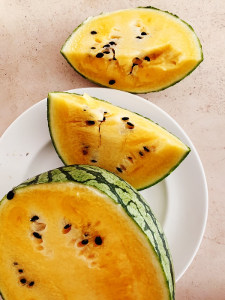
When your dog is a little peckish and just begging for a treat, don’t rush to the cupboard to give him some store-bought bone full of God knows what.
Try a fruit, there are quite a few that are very healthy for dogs, including watermelons.
Red or yellow, watermelons are one of the foods you can totally share with your pet.
In this article, we’ll be looking at yellow watermelons, because, although they’ve been on the market for quite some time, people are still a bit confused about them.
What is yellow watermelon?
On the outside, a yellow watermelon looks exactly like a red one. Both have the same dark green striped rind, sometimes a bit cracked from spending too much time in the sun.
The big difference is on the inside and it’s pretty obvious. The flesh is a bright vibrant yellow, not red or pink. It has the same crunch to it, but yellow watermelons are sweeter than red ones. They taste a bit like honey, which makes them a better choice over red ones. With red ones, it’s like the lottery, some are deliciously sweet, while others not so much, they look ripe, but they’re not. With a yellow watermelon, you cannot go wrong.
Just as with red watermelons, you can find seedless yellow watermelons which are the best for your dog.
What other colours of watermelon are there?
Some people wonder if yellow watermelons are a natural thing. Yes, the yellow colour of the flesh is a perfectly natural mutation and some farmers prefer to grow this kind exclusively, not only because it is sweeter, but also because it’s still a novelty for many people.
Since we’re talking about novelty watermelons, there are other weird colours you might find on the market. There’s a type of orange watermelon, just as sweet as the yellow variety, but there’s also a white type of watermelon. The Cream of Saskatchewan variety might be a bit off-putting with its pale white flesh, but it still tastes like watermelon, not as sweet as the yellow one though.
Why do watermelons come in different colours?
When you see a yellow watermelon for the first time, it might seem a bit odd, but the difference in colour is easy to explain.
Red watermelons are rich in lycopene, which is a pigment that gives them this colour. Other fruits that contain plenty of lycopene are tomatoes and pink grapefruit.
Is it healthy for your dog?
If you’re considering giving your dog yellow watermelon, that’s an excellent choice as it’s rich in vitamins and antioxidants.
Yellow watermelons, just like the red ones, are mostly water, 92% water to be exact. This makes watermelons a great fruit to keep your dog well hydrated on a hot summer day.
Yellow watermelons are a good source of vitamins A and C, which both support the immune system. Vitamin A is also good for the eyes, so it’s the perfect treat for a mature pet who’s already experiencing vision problems. At the same time, vitamin C is also good for a dog’s skin and helps maintain blood vessels’ elasticity, again very important for senior pets.
As compared to other fruits, yellow watermelons are a low-calorie snack. One cup of chopped yellow watermelon has only 46 calories.
As far as carbs are concerned, the same serving size has 12 grams of carbohydrates, which your little buddy needs for energy.
Some people wonder about giving their pet a treat that seems a bit high in carbs, and most of those 12 grams are sugars. The good news is that those sugars are isolated by the fiber so they will release slowly into the bloodstream.
It’s not like giving your dog a cookie that might cause a quick blood sugar level spike.
Red watermelons are touted as a great fruit to treat a dog since they are a good source of lycopene, which is not only a pigment, but also a powerful antioxidant. Yellow watermelons do not have lycopene, but they make up for it being rich in beta carotene.
This compound, abundant in carrots, is also an antioxidant with many health benefits. For one thing, the body converts it into vitamin A, which is good for the eyes.
At the same time, being an antioxidant, beta carotene fights against the damage caused by free radicals and can prevent various types of cancer. And dogs are not immune to cancer, unfortunately.
How much yellow watermelon can you feed your dog?
There are no clear guidelines as to how much watermelon of any colour you can feed your dog. This will depend largely on your dog’s size. A big German Shepherd can have more than a small poodle.
However, for a medium-size dog a two-inch slice of watermelon should be plenty. Cut the flesh of the fruit into small easy to chew pieces. As with all new foods, start by offering just a couple of pieces, especially if your dog has a sensitive stomach. It’s not something you should give your dog everyday, a couple of times per week should be enough. Eating too much watermelon might give your pet diarrhea.
If you have any concerns about it, you should ask your vet how much watermelon, red or yellow, your dog can be safely fed.
Can dogs eat the skin of a yellow watermelon?
You should never allow your dog to chew on the rind of any type of watermelon. The main reason is that it might irritate its GI tract and cause diarrhea. At the same time, even if you do wash the watermelon carefully you don’t know where it was grown and how, so you cannot be sure the rind is not full of pesticides and other nasty chemicals.
Finally, watermelon rind is a choking hazard. It’s hard which makes it fun to chew, but not very hard and the dog might accidentally swallow a chunk big enough to get stuck in his throat. Also, if a big chunk somehow makes it to the stomach it will not be digested much and might end up causing an intestinal blockage.
Can dogs eat the seeds of a yellow watermelon?
Yellow watermelons have big black seeds and smaller white ones, which are immature seeds. According to experts, watermelon seeds are not safe for dogs. It’s not the compounds in them that make them dangerous, but, ingested in large quantities, they might cause an intestinal blockage and this condition can be life-threatening for your pet.
It is recommended that you remove both white and black seeds before offering watermelon to your dog. Don’t worry if you miss one or two, your dog will pass those without any problem, no matter the size of your pet.
Should a puppy be allowed to eat watermelon?
There’s no reason why a puppy shouldn’t get a bit of watermelon. Besides the many healthy benefits mentioned above, watermelons are a good source of calcium and potassium, which makes them perfect for a growing dog.
You should be extra careful with the seeds though. If a large dog won’t have a problem swallowing a few seeds, they might get stuck in a small pups’ throat.
Other than that, your puppy will enjoy a few bites of watermelon. Just make sure your puppy doesn’t drink a lot of water after this yummy treat.
Hydration is essential for dogs, but over hydration might cause him an upset stomach.
How to serve yellow watermelon to a dog
Obviously, your dog will eat it raw, just as you do, but you can be a little creative and make frozen treats for your dog, if he has a good set of teeth to sink into it that is.
All you have to do is scoop the flesh of the watermelon and put it in the blender.
Pour the smooth liquid into bone-molds and stick them in the freezer for a few hours. It will make a much appreciated and fun treat for your pet, but don’t give him too much.
Keep in mind just how much flesh went into the blender and make sure the amount he gets doesn’t add up to more than one wedge.
What is the best fruit to feed your dog?
A healthy dog should get a bit of fruit every day to get enough vitamins, but also other micro-nutrients they don’t get from their normal food. Since fruit count as treats, remember that snacks should not account for more than 10% or your dog’s diet.
Apples and bananas are very healthy for dogs, not only for the vitamins, but also because they have a high-fiber content and this is very good for their digestion.
Also, berries are a nice treat, especially because they’re full of antioxidants.
And speaking of watermelons, the other type of melon, the cantaloupe is also recommended for dogs, again without seeds and cut into bite-size pieces.
Closing Thoughts
If you’re a fan of sweet yellow watermelons, don’t hesitate to give your dog some. Yellow watermelons are very healthy as they are rich in vitamins A and C, as well as beta carotene. Always make sure to remove the seeds as much as possible and cut the flesh in small pieces. Your dog will probably love the taste, but don’t overfeed him watermelon of any colour as it might upset his stomach.





